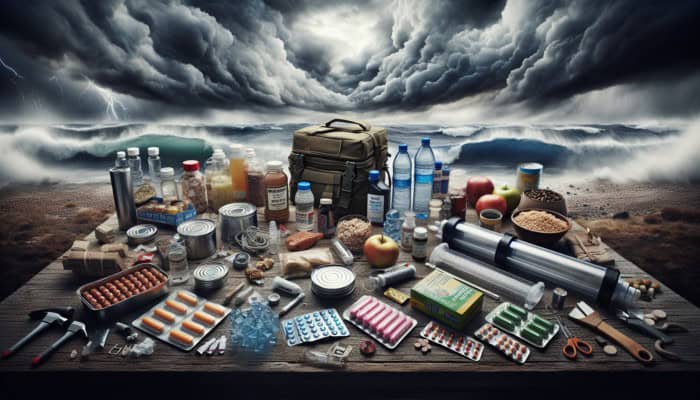Essential Steps to Prepare for Emergencies
Creating a Comprehensive Survival Kit for Emergencies

A truly effective SHTF survival plan commences with the meticulous assembly of a versatile survival kit. This essential kit should encompass vital items such as clean drinking water, non-perishable food, medical supplies, and essential tools required for survival. A well-designed survival kit serves not merely as a collection of supplies but as a vital lifeline during emergencies, offering comfort and security in unpredictable circumstances. Begin by prioritising clean water; consider including water purification tablets or a portable filtration system to guarantee access to safe drinking water. Subsequently, stock up on food items that require minimal preparation, including energy bars, canned goods, and dehydrated meals.
Medical supplies are equally important; a basic first aid kit containing bandages, antiseptics, and essential over-the-counter medications can prove invaluable in times of need. Additionally, do not underestimate the necessity of tools such as a multi-tool, flashlight, and materials for fire-starting. It is crucial to regularly inspect and update every item in your kit, ensuring that supplies remain effective and current. Tailor your survival kit according to your local environment; for example, if you reside in an area susceptible to earthquakes, include items like sturdy footwear and a whistle for signaling.
A well-thought-out approach to constructing your survival kit can vastly improve your resilience in a crisis, empowering you to confront emergencies with heightened confidence and preparedness.
Establishing Effective Emergency Communication Plans
Creating strong communication strategies is critical to any successful SHTF survival plan. In times of crisis, traditional and modern communication technologies can play an instrumental role in maintaining contact with family and friends. Start by devising a communication hierarchy: assign specific contacts and communication channels for various scenarios. For instance, phone calls may prove more effective during a local disaster, while text messages or social media might be suitable for broader situations.
Moreover, consider investing in a two-way radio system, particularly for families dispersed across different locations or those residing in areas with unreliable mobile networks. All family members must understand and practice the communication plan regularly to ensure everyone knows how to act during an emergency. Additionally, augment your communication strategy with a physical map and a list of critical phone numbers, as digital devices may fail when needed.
Furthermore, establishing predetermined meeting points where family members can convene if communication fails is highly beneficial. This provides peace of mind and a clear plan of action amidst the chaos of an emergency. In essence, effective communication bolsters safety and cultivates a supportive network during challenging times.
Acquiring Basic First Aid Skills for Emergencies
Understanding basic first aid is an indispensable skill that can dramatically enhance survival chances during emergencies. A foundational aspect of your SHTF survival plan should involve training in first aid techniques. Begin by familiarising yourself with common injuries and appropriate responses, including wound care, CPR, and management of allergic reactions. Numerous organisations offer certification courses, such as the Red Cross or St John Ambulance, providing hands-on experience that builds your confidence in practical skills.
Consider equipping your first aid kit with supplies tailored to the prevalent injuries in your area. For example, individuals in rural settings might require supplies for animal bites or insect stings, while those in urban environments should prepare for cuts and abrasions from various hazards. Additionally, maintaining calm under pressure is paramount; learning to manage stress during emergencies enhances your effectiveness and reassures those around you.
Moreover, contemplate creating first aid pamphlets or resources outlining basic procedures to keep readily available. This can assist others seeking help during a crisis, enhancing community preparedness. Ultimately, the capacity to deliver immediate care can significantly affect survival outcomes.
Formulating a Practical Evacuation Strategy

A well-structured evacuation strategy is a fundamental component of any serious SHTF survival plan. Given that emergencies can occur unexpectedly, it is essential to prepare for multiple escape routes and identify safe meeting points. Start by mapping out various routes from your residence to predetermined safe locations, considering local geography and potential hazards.
Evaluate the scenarios that may necessitate evacuation, such as natural disasters, civil unrest, or industrial accidents, and tailor your routes to these possibilities. Practising these routes with your family will ensure everyone is familiar with the plan, thereby reducing panic during evacuation situations.
In addition to geographical routes, it is vital to establish safe meeting locations where all family members can regroup. This might be a neighbour’s house, a local community centre, or a designated area in a nearby park. When selecting these spots, consider accessibility and safety; they should be places to await further instructions or assistance.
Moreover, keep emergency kits in your vehicle and at predetermined meeting points to guarantee that essential supplies are readily available. An adaptable and well-communicated evacuation strategy can drastically enhance your family’s safety and preparedness in an emergency.
Ensuring Shelter and Safety During Emergencies
Identifying Secure Locations for Refuge
Recognizing secure locations for refuge during emergencies is a crucial component of your SHTF survival plan. Knowing safe locations can be vital when immediate action is required, whether you find yourself at home or away. When evaluating potential shelters, consider accessibility, structural integrity, and proximity to hazards. For instance, identifying high ground or sturdy buildings that can endure severe weather conditions is essential if you reside in a flood-prone area.
Commercial buildings like shopping centres or libraries frequently serve as temporary shelters in urban settings during emergencies. Local community halls or well-designed outdoor spaces may provide refuge in rural areas. Assessing these locations in advance ensures you are not left scrambling during a crisis, enabling quick decision-making when it matters most.
Additionally, it is vital to evaluate the safety protocols in place at these locations. Ensure they have reliable communication means, adequate resources, and trained personnel to assist during emergencies. Familiarising yourself and your family with these locations fosters a sense of security, empowering everyone to act confidently should the need arise. Ultimately, taking proactive steps to choose safe locations can greatly enhance your ability to navigate crises effectively.
Strengthening Your Shelter Against Threats

Fortifying your living environment against potential threats is essential to your SHTF survival plan. A well-secured shelter offers physical protection and mental reassurance, knowing that you have taken steps to ensure your safety. Begin by evaluating your home for vulnerabilities; inspect entry points like doors and windows for potential weaknesses. Strengthen these areas with robust locks, security bars, or even reinforced glass where necessary.
In addition to securing access points, consider the structural integrity of your home. Investing in storm shutters or braces can mitigate damage if you reside in a region susceptible to severe weather. Creating a safe room within your home can also prove beneficial; this should be a fortified space stocked with essential supplies, providing a refuge during a crisis.
Furthermore, we should not underestimate the strength of the community. Engaging with neighbours to establish a collective security approach can enhance safety for everyone involved. Forming watch groups or participating in local safety initiatives can foster a sense of unity and preparedness. A proactive approach to fortifying your shelter ensures you feel secure and ready in uncertain times.
Implementing Safety Protocols for Households
Establishing and practising safety protocols is vital for protecting your household against hazards and emergencies. Incorporating these protocols into your SHTF survival plan ensures all family members understand the necessary steps during a crisis. Begin by conducting regular safety drills; practise fire evacuations, earthquake responses, or lockdown procedures, tailored to the risks prevalent in your area.
Clearly outlining safety measures, such as where to go, what to bring, and how to communicate during emergencies, will help alleviate confusion and anxiety. Distributing printed materials or diagrams can serve as handy reminders for everyone involved.
Creating a communication tree within your household guarantees everyone knows whom to contact and how to relay information swiftly. Assigning roles among family members can further streamline the response process. Consider delegating tasks like gathering emergency kits, checking on pets, or monitoring the situation outside to promote collaboration and efficiency.
Moreover, keeping up to date with local safety resources and updates can enhance your preparedness. Subscribing to alerts or community safety bulletins can provide valuable insights regarding potential threats in your area. A comprehensive approach to safety protocols safeguards your family and instills a culture of readiness and resilience.
Assembling Emergency Kits for Preparedness
Compiling emergency kits with essential supplies is foundational to any effective SHTF survival plan. These kits should be strategically positioned for easy access, ensuring quick access during crises. Include food, water, medical supplies, and hygiene items in your kits.
Regarding food, consider non-perishables like canned goods, dried fruits, and protein-rich snacks that are easy to store and consume. Explore water purification options, such as filters or purification tablets, which can help guarantee access to safe drinking water when resources are scarce.
Medical supplies should be personalized to your family's specific needs, encompassing medications, first aid essentials, and any specialised items for chronic conditions. Additionally, remember to incorporate hygiene products such as soap, hand sanitiser, and personal care items to maintain health and sanitation during emergencies.
Regularly check and update your kits to ensure that all items are in good condition and that food and medications remain within expiry dates. Involving your family in the assembly and review process guarantees that everyone knows the kit's contents and how to utilise the items effectively. A well-prepared emergency kit can significantly influence comfort and survival during challenging times.
Efficient Management of Resources
Strategies for Water Procurement and Purification
Access to clean water is a pivotal element of your survival plan, as dehydration can occur rapidly during emergencies. Understanding water procurement and purification techniques will bolster your ability to survive when traditional sources are compromised. Consider various methods for sourcing water, including collecting rainwater, finding streams or ponds, or even digging for groundwater in specific terrains.
Once water is sourced, it is crucial to ensure its safety through purification methods. Boiling water remains one of the most effective techniques; bringing water to a rolling boil for at least one minute can eliminate harmful pathogens. Additionally, consider investing in water filters or purification tablets, which can provide reliable means for making water safe for consumption.
While learning to identify and access water sources is vital, preparation is equally significant. Develop a plan for storing water in clean, durable containers, and routinely rotate your stored water to maintain freshness.
Furthermore, familiarizing yourself with local regulations regarding water sources and purification methods can enhance your preparedness. In a world where water scarcity is a significant threat, being proactive about water procurement and purification significantly increases your resilience during crises. Practical Food Storage and Preservation Techniques
A well-planned food storage and preservation strategy is a cornerstone of any effective SHTF survival plan. Building a sustainable food supply demands careful consideration of the types of food to store and the methods employed to preserve them. Start by accumulating non-perishable items such as canned goods, dried grains, legumes, and freeze-dried meals, as these boast long shelf lives and require minimal preparation.
In addition to purchasing pre-packaged items, consider learning preservation techniques such as canning, dehydrating, and fermenting. Each method allows you to extend the life of fresh produce, ensuring a diverse diet during emergencies. When properly sealed, canning lets you store fruits, vegetables, and meats that can last for years. Simultaneously, dehydrating fruits and vegetables helps retain their nutrients while making them lightweight and compact for storage.
Finally, a rotation system should ensure that older items are consumed first, preventing waste. Regularly assess your inventory to identify products that need replenishing and maintain detailed records to help manage your supplies effectively. A proactive food storage and preservation approach enhances your self-sufficiency, ensuring you and your family can access nutritious food during emergencies.
Optimising Energy and Power Management
Effective energy and power management can be a game changer in any SHTF survival plan during emergencies. Exploring alternative energy solutions is crucial as traditional power sources may become unreliable. Solar panels, portable generators, and wind turbines can provide a sustainable power supply when the grid fails. Investing in solar chargers for small devices can also maintain communication and access to information during crises.
Moreover, understanding energy conservation is equally important. Simple adjustments, such as using energy-efficient appliances, can greatly reduce energy demands. Create a plan for power rationing that prioritizes essential functions, including refrigeration for food, lighting, and communication devices.
In addition to renewable sources, consider establishing a stockpile of generator batteries and fuel, storing them safely and accessibly. Regularly check and maintain your equipment to ensure it’s functional and ready for use.
Lastly, engage in community initiatives focused on energy resilience, as sharing resources and knowledge can amplify your collective preparedness. Ultimately, a well-planned energy and power management approach enhances your ability to navigate emergencies confidently and sustainably.
Developing Key Survival Skills
Mastering Fire-Starting Techniques for Survival
Fire is a crucial element of any SHTF survival plan, offering warmth, a means for cooking, and a way to signal for help. Mastering various fire-starting techniques guarantees you can create a flame under diverse conditions. Start by familiarizing yourself with natural fire-starting materials available in your environment, such as dry leaves, twigs, and bark.
Practice using different tools for igniting fire—matches, lighters, and fire starters are common. However, using flint and steel or a bow drill can tremendously benefit survival. Each method requires practice; becoming proficient in multiple techniques will enhance your chances of success when faced with adverse conditions, including rain or high winds.
When constructing a fire, consider the configuration itself. Employ techniques like the teepee or log cabin to ensure the fire burns efficiently. Each setup has advantages depending on the available materials and the desired outcome.
Moreover, educate yourself on fire safety protocols to ensure that you can manage a fire without creating unintended hazards. Always keep a water source nearby to extinguish the fire when necessary, leaving no trace behind. Mastering fire-starting techniques will significantly bolster your survival capabilities, providing warmth, nourishment, and security.
Developing Navigation and Orientation Skills
During times of crisis, the ability to navigate without modern tools can be an invaluable skill within your SHTF survival plan. Familiarizing yourself with natural landmarks and celestial bodies can effectively guide you through unfamiliar terrain. Start by learning to identify key navigational features in your local environment, such as rivers, mountains, or distinctive trees that can serve as reference points.
Understanding the cardinal directions is essential. The sun rises in the east and sets in the west, and during the day, its position can assist you in orienting yourself. The North Star can serve as a reliable guide in the northern hemisphere at night. Learning how to read a compass is a valuable skill that can complement your natural navigation abilities.
Practice these skills in various environments, including forests, mountains, or urban areas, to build confidence in your navigation techniques. Consider enrolling in outdoor survival courses that focus on navigation, as they can provide practical experience and expert guidance.
Moreover, always carry a physical map of your area, as technology can fail during emergencies. Learning to read a map and knowing about natural navigation can significantly increase your chances of finding your way during a crisis. Ultimately, mastering navigation skills empowers you to explore and traverse different terrains confidently and purposefully.
Understanding Foraging and Hunting Basics
Acquiring knowledge about foraging and hunting is an invaluable aspect of a comprehensive SHTF survival plan. Identifying edible plants and employing basic hunting techniques can supplement your food supplies during emergencies. Start by familiarizing yourself with local flora and distinguishing between edible and toxic plants. Resources like field guides or local workshops can enhance your understanding of foraging in your region.
When it comes to hunting, consider enrolling in a hunter's safety course to learn about regulations, ethical hunting practices, and the proper techniques. Understanding the behavior of local wildlife can substantially increase your success rate, allowing you to harvest animals that provide essential protein sources.
Practice your skills safely, honing your tracking, trapping, and skinning techniques. Furthermore, consider forming a community group focused on foraging and hunting; sharing knowledge and resources can enrich your experiences and enhance preparedness.
In addition to food acquisition, understanding preservation methods for wild game and foraged items is crucial. Actively engaging in these practices increases self-sufficiency and fosters a deeper connection with the land around you, enhancing your resilience during emergencies.
Building and Maintaining Effective Shelters
Knowing how to construct and maintain shelters using natural materials is vital to your SHTF survival plan. During emergencies, having a secure space to rest and protect yourself from the elements can be the difference between survival and failure. Depending on available materials, begin by familiarizing yourself with the types of shelters appropriate for various environments, such as a lean-to, debris hut, or A-frame.
When constructing a shelter, prioritise the location and seek natural features that offer protection from wind and rain. Build your shelter with insulation materials; branches, leaves, and moss can be excellent natural insulators. Additionally, ensure that your shelter has adequate ventilation to prevent moisture buildup.
Regularly maintain your shelter by checking for damage and necessary repairs, especially after severe weather events. Familiarity with the local environment and its materials enables you to adapt your shelter-building techniques based on available resources.
Moreover, consider involving others in your shelter-building practice to create a community of preparedness. Sharing knowledge and collaborating on projects can enhance skills and build relationships that benefit everyone involved. Mastering shelter construction and maintenance will enhance your survival capabilities, providing security and comfort when it matters most.
Establishing a Support Network
Building Strong Community Connections
The strength of your support network is a fundamental aspect of an effective shtf survival plan. Cultivating relationships with neighbours and local groups fosters a sense of community and creates a reliable support system during crises. Begin by actively engaging with your neighbours; attend local events, join community organisations, and volunteer to strengthen bonds within your area.
In addition to personal connections, consider forming or joining local preparedness or survival groups. These groups often focus on sharing knowledge and resources, conducting training sessions, and hosting preparedness drills, which can enhance your skills and confidence. A network of like-minded individuals can provide emotional support, practical assistance, and even resources in times of crisis.
Additionally, consider utilizing local social media platforms or community boards to connect with others interested in emergency preparedness. Sharing information, tips, and resources can create a richer community experience and foster a culture of readiness.
Creating a diverse support network that includes individuals with various medical, technical, or tactical skills can offer a comprehensive resource pool for everyone involved. Ultimately, the connections you forge within your community can significantly enhance your resilience and preparedness when facing adversity.
Engaging in Survival Groups for Collective Preparedness
Joining or forming survival groups is a proactive strategy within any SHTF survival plan. These groups allow you to share knowledge and skills with others. These groups often concentrate on collective preparedness, hosting workshops and training sessions that cover various survival techniques, from foraging and hunting to first aid and navigation.
When participating in a survival group, actively engage in discussions and share your experiences. Learning from others and sharing your insights can enhance everyone's skill sets and foster a deeper understanding of survival techniques. Consider organising regular meetups to practise skills and drill emergency scenarios, which can bolster confidence.
In addition to practical skills, survival groups frequently share resources, such as equipment and information about local hazards. Establishing a cooperative approach allows members to benefit from each other's strengths, creating a safety net for all involved.
Furthermore, consider each member's unique skills to the group; collectively, these can create a well-rounded team prepared for various emergencies. Participating in survival groups enhances your preparedness and builds a community dedicated to resilience and self-sufficiency.
Utilising Online Communities for Enhanced Knowledge
Leveraging online platforms to connect with others interested in survival strategies can significantly enhance your SHTF survival plan. Online communities on social media, forums, and dedicated websites offer a wealth of information, enabling you to exchange ideas, ask questions, and seek advice from experienced individuals worldwide.
Joining these communities can provide access to valuable resources, such as instructional videos, articles, and guides covering various survival topics. Participating in discussions can also help you stay updated on the latest trends and techniques in emergency preparedness, enriching your knowledge base.
Moreover, consider contributing your experiences and insights to these online platforms. Sharing your journey can inspire others and foster a sense of camaraderie within the community.
Do not underestimate the importance of networking with individuals who may offer unique perspectives or skills that can enhance your preparedness journey. Leveraging online communities can substantially improve your survival knowledge and create valuable connections beyond geographical boundaries.
Maintaining Mental and Physical Well-Being
Implementing Stress Management Techniques
Developing effective stress management techniques is crucial for maintaining mental well-being during emergencies. High-stress situations can impair decision-making and affect overall resilience. Start by incorporating mindfulness practices, such as meditation or deep-breathing exercises, into your daily routine. These techniques can help center your thoughts and provide a sense of calm amidst chaos.
In addition to mindfulness, engaging in physical activities, such as yoga or exercise, can be an excellent outlet for stress relief. Regular physical activity promotes the release of endorphins, enhancing mood and fostering mental clarity. Establishing a balanced fitness routine can strengthen physical and mental resilience, allowing you to navigate emergencies more easily.
Furthermore, consider developing a support system comprising friends and family to whom you can turn during challenging times. Open communication about your feelings and experiences can alleviate stress and cultivate a sense of community and belonging.
Finally, do not overlook the importance of self-care. Prioritising sleep, nutrition, and relaxation can greatly influence your ability to manage stress effectively. Developing stress management techniques ultimately empowers you to confront crises with confidence and composure.
Building Physical Fitness and Endurance
Engaging in regular exercise and enhancing physical fitness are vital components of a comprehensive SHTF survival plan. The demands of emergencies often require strength, stamina, and endurance, making physical preparedness essential. Begin by incorporating a balanced fitness routine that includes cardiovascular, strength training, and flexibility exercises.
Cardiovascular activities like running, cycling, or swimming can improve your endurance and stamina, preparing you for prolonged physical exertion during emergencies. Strength training will help build muscle, making it easier to lift heavy objects or traverse rough terrain. Additionally, including flexibility exercises, such as yoga or stretching, can enhance overall mobility and reduce the risk of injury.
Consider setting realistic fitness goals to help maintain motivation and track progress. Involving family members in your fitness journey can foster teamwork and make workouts more enjoyable.
Moreover, participating in local fitness classes or outdoor activities can create opportunities to connect with others while improving your physical preparedness. Maintaining physical fitness and endurance will significantly enhance your ability to navigate emergencies with strength and resilience.
Practising Hygiene and Sanitation Techniques
Maintaining personal hygiene and proper sanitation is crucial for promoting health and preventing illness during emergencies. In the midst of a crisis, it can be easy to neglect hygiene, yet doing so can lead to severe health risks. Start by establishing a hygiene kit that includes soap, hand sanitizer, toothbrushes, and sanitary supplies.
In addition to personal care items, educational resources on hygiene practices should be considered, such as creating makeshift toilets or managing waste disposal in emergencies. Understanding these techniques can significantly enhance your hygiene practices during crises, preventing the spread of disease.
Encourage family members to prioritise hygiene, even in challenging circumstances. Establish handwashing, cleanliness, and waste management routines to cultivate a culture of health and safety within your household.
Furthermore, consider involving your community in hygiene education initiatives to promote a collective approach to health during emergencies. Information and resources can help ensure everyone is equipped to manage hygiene effectively. Ultimately, maintaining hygiene and sanitation practices will greatly bolster your ability to navigate emergencies with health and security.
Adapting to Changing Conditions in Emergencies
Evaluating and Responding to Threats
Cultivating skills to assess risks and adapt strategies is essential for ensuring safety and survival during emergencies. An effective SHTF survival plan requires a proactive approach to threat assessment, considering potential hazards and their potential impacts on your situation. Start by familiarizing yourself with local risks, such as natural disasters, industrial accidents, or civil unrest, and understanding the indicators that may signal an impending crisis.
Monitor news sources, community alerts, and weather updates regularly to remain informed about potential threats. Developing a keen awareness of your surroundings will enable you to identify changes that may necessitate a response.
In addition to assessing threats, establish a flexible response plan that allows for swift adjustments based on evolving circumstances. Practising various emergency scenarios with your family can ensure that everyone is prepared to adapt quickly.
Finally, stay open to learning from experiences and gathering insights from trusted sources. Continuously improving your threat assessment and response skills will enhance your overall preparedness, enabling you to navigate changing conditions with confidence and poise.
Improvising with Available Resources in Crisis Situations
Mastering the art of improvisation is a valuable skill in any SHTF survival plan, as emergencies often demand creative solutions to effectively use available resources. Start by familiarizing yourself with the materials in your environment, such as natural elements like wood, stone, or plants, and everyday items that can be repurposed for various needs.
Consider engaging in exercises that challenge you to solve problems using limited resources. For instance, practise building a shelter from natural materials or creating a makeshift fishing rod using items you have on hand. These exercises enhance your resourcefulness and build confidence in your capabilities.
Moreover, it encourages family members to participate in improvisational activities, fostering a collective mindset of creativity and adaptability. Sharing ideas and solutions can lead to innovative approaches and strengthen team preparedness.
Finally, cultivate relationships with individuals who possess unique skills or knowledge that can enhance your improvisation toolkit. Learning from diverse perspectives can deepen your understanding of maximizing available resources, ultimately increasing your resilience during emergencies.
Monitoring Environmental Changes for Safety
Regularly observing and analysing environmental shifts is essential for anticipating potential impacts on your situation. An effective SHTF survival plan necessitates an awareness of natural cues and changes that may foreshadow upcoming hazards. Start by familiarizing yourself with local wildlife patterns, weather changes, and seasonal cycles. Understanding these elements can provide valuable insight into potential threats like flooding, storms, or wildfires.
Utilise technology, such as weather apps or environmental monitoring tools, to stay informed about changes in your area. Additionally, join local ecological groups focusing on conservation or monitoring initiatives, as these communities can provide valuable information and resources.
Engage your family in the observation process, encouraging them to share their insights and observations. Creating a culture of awareness within your household fosters preparedness and ensures everyone is vigilant about potential dangers.
Lastly, regularly updating your knowledge about environmental changes will enhance your ability to adapt your survival plan. Ultimately, being attuned to your surroundings enables you to make informed decisions, ensuring safety and security during crises.
Maintaining Flexibility in Emergency Plans
Any effective SHTF survival plan requires the ability to adjust strategies in response to new information or unforeseen circumstances. Flexibility allows you to remain resilient when conditions change, ensuring ongoing progress towards your goals. Start by regularly reviewing and updating your plans based on personal experiences and lessons learned from past events.
Establish a communication culture within your household, where family members feel encouraged to share their thoughts and concerns. This open dialogue fosters adaptability, allowing everyone to contribute their insights and perspectives.
In addition to personal adaptability, remain receptive to learning from external sources. Engaging with online communities, attending workshops, or participating in local training sessions can provide fresh ideas and strategies for navigating emergencies.
Moreover, practise scenario-based drills that challenge your ability to pivot quickly in response to changing conditions. Regularly participating in these exercises will enhance your readiness and confidence, enabling you to manage crises effectively.
Ultimately, maintaining flexibility in your plans fosters resilience and empowers you to respond to challenges, ensuring safety and security for you and your loved ones.
Frequently Asked Questions About SHTF Survival
What constitutes an SHTF survival plan?
An SHTF survival plan is a comprehensive strategy to prepare individuals and families for unforeseen emergencies or catastrophic events that disrupt normality, ensuring safety, security, and access to essential resources.
What items should I include in a survival kit?
A survival kit should encompass essentials such as water, non-perishable food, medical supplies, a flashlight, batteries, a multi-tool, hygiene products, and any necessary personal items or medications tailored to your specific needs.
How can I maintain communication with loved ones during an emergency?
Establish a communication plan that includes traditional methods (e.g., landlines) and modern technologies (e.g., messaging apps). Designate a meeting point and exchange contact information to ensure everyone stays connected.
What basic first-aid skills should I acquire?
Basic first-aid skills encompass wound treatment, CPR, responding to allergic reactions, and managing common injuries. To gain practical experience and knowledge, consider undertaking a certified first-aid course.
How can I secure food during an emergency?
Knowing how to forage for edible plants and hunt small game can be invaluable in emergencies. Familiarise yourself with local resources and consider participating in survival workshops to enhance your skills.
What types of shelters can I construct in the wild?
You can create various shelters in the wild, such as a lean-to, a debris hut, or an A-frame. Based on the resources available, each type uses natural materials to provide protection from the elements.
How can I manage stress during a crisis?
Managing stress during a crisis involves practising mindfulness techniques, engaging in physical activity, and maintaining open communication with loved ones. Establishing self-care routines can also enhance mental well-being.
Why is physical fitness vital for survival?
Physical fitness is essential for survival, enhancing endurance, strength, and overall resilience during emergencies. Regular exercise prepares you to handle physical demands and improves mental clarity in stressful situations.
What actions can I take to enhance my community’s preparedness?
Enhancing community preparedness entails establishing connections with neighbours, participating in local survival groups, and sharing resources and knowledge about emergency planning with others in your area.
How can I stay informed about environmental changes?
Stay informed about environmental changes by monitoring news sources, engaging with local environmental groups, and using technology like weather apps to track shifts that may impact your safety.
Follow our journey on X!
Preparing for Pandemics: Essential Strategies for Safety
Fundamental Principles for Effective Pandemic Preparation Grasping Essential Health Concepts A thorough understanding of essential health concepts is crucial for preparing for pandemics. This comprehension encompasses a wide range of topics, including effective hygiene practices, comprehensive vaccination strategies, and the meticulous allocation of resources. It is imperative that communities are equipped with the necessary tools […]
Emergency Water Sources: Essential Tips for Survival
Comprehensive Guide to Emergency Water Sources What Constitutes Emergency Water Sources? Emergency Water Sources: Emergency water sources are vital for survival during unexpected crises, significantly influencing one's ability to access safe hydration when regular supplies become unavailable. These sources may be natural, such as rivers, streams, and springs, or stored, such as bottled water. The primary […]
SHTF Security Measures: Key Strategies for Preparedness
Essential Guidelines for Effective SHTF Security Measures Deepening Your Understanding of Key Security Concepts SHTF Security Measures: To implement successful SHTF security measures, a comprehensive understanding of foundational concepts is crucial. This includes proactive planning, resource management, and risk assessment. In times of uncertainty, the capacity to foresee and react to potential threats becomes vital. By adopting […]
Emergency Sleeping Bags: Essential for Outdoor Emergencies
Comprehensive Guide to Emergency Sleeping Bags Exploring the Essential Features of Emergency Sleeping Bags Emergency Sleeping Bags: These bags are invaluable resources designed to provide vital warmth and protection during unforeseen events. These bags are usually made from lightweight, waterproof materials, providing excellent insulation while safeguarding users from harsh weather. Their innovative design frequently includes […]








This post sheds light on something crucial that many people often overlook: the importance of a well-thought-out survival kit. As someone who has delved into emergency preparedness, I’ve come to realize that the process of assembling a survival kit can be as enlightening as it is practical. It forces you to think critically about what you might need in an emergency and encourages you to consider what your personal needs and circumstances are.
Your exploration of the essential steps to prepare for emergencies truly resonates with me. The emphasis on a well-rounded survival kit is paramount, especially in today’s unpredictable world. It’s fascinating how preparedness can transform not just our own peace of mind, but also that of our families and communities.
I really appreciate your approach to creating a comprehensive survival kit and the emphasis on prioritizing clean water. It’s interesting how often people overlook that as a critical element until it’s too late. Growing up in a region prone to natural disasters, I’ve seen firsthand how vital it is to have a reliable source of drinking water when everything else seems uncertain. I remember during a hurricane, our power was out for a week, and the convenience of having water purification tablets made a huge difference for my family.
Your post really highlights how crucial a well-prepared survival kit is. When I put mine together, I focused not just on essentials like water and food but also on adding a few comfort items—like a deck of cards and a small book. It might sound trivial, but I think those little things can help maintain morale during tough times.
You’re spot on about the importance of comfort items in a survival kit. It’s easy to focus solely on the basics—water, food, first aid—but having things that uplift our spirits can really make a difference in challenging situations. A deck of cards or a good book can turn a long day into something more manageable, offering a needed distraction and even a sense of normalcy.
“I’m glad you see the value in comfort items; they can make a big difference! If you’re interested, check out this guide for more tips on creating a well-rounded survival kit.”
https://survivalbite.com/wild
I completely agree with you about the importance of comfort items in a survival kit. It’s interesting how even in challenging situations, our mental and emotional well-being can greatly influence our ability to cope. Having a deck of cards or a book can provide a sense of normalcy and distraction, not to mention the chance to connect with others if you’re in a group situation.
You’ve highlighted such a crucial aspect of emergency preparedness! I remember when we faced a power outage that lasted several days; it really drove home the importance of having a well-thought-out survival kit. I found that having not just food and water, but also items like portable phone chargers and even a good flashlight made a world of difference.